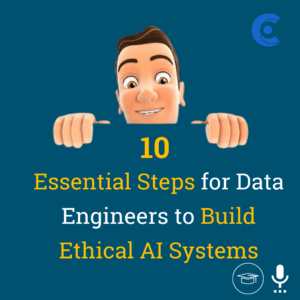
In the rapidly evolving landscape of Artificial Intelligence (AI), ensuring the responsible and ethical development of AI systems is paramount. Data engineers, who are at the forefront of AI model creation, play a pivotal role in this process. One of the most pressing concerns in AI development is the potential for bias and fairness issues to emerge. Here, we present 10 essential steps that data engineers can take to build ethical AI systems, addressing these concerns and fostering a more equitable AI ecosystem.
1. Data Collection and Evaluation: Data engineers should begin by carefully evaluating the data sources they intend to use. It’s essential to assess the potential biases inherent in these sources and consider the fairness implications. Scrutinizing data collection methods and sources helps identify and mitigate any inherent prejudices.
2. Diverse Data Representation: To avoid underrepresentation and skewed results, data engineers should ensure that the training data encompasses a diverse range of demographics, characteristics, and perspectives. A diverse dataset is the foundation of fairness.
3. Bias Assessment: Implementing bias assessment tools and metrics is crucial. Regularly audit datasets to detect and mitigate any biases that may arise during the data engineering process. Transparent and objective bias assessment is key to addressing this issue.
4. Data Preprocessing: Data preprocessing techniques, such as data cleaning and data augmentation, should be applied to reduce biases and enhance the quality of training data. This step helps in minimizing data-related issues that could lead to unfair outcomes.
5. Algorithm Selection: Data engineers should carefully select machine learning algorithms known for their fairness and transparency. Consider interpretable models that allow for easier bias detection and mitigation during model development.
6. Fairness Evaluation: Develop fairness evaluation frameworks to assess how AI models may impact different demographic groups. Metrics like disparate impact and equal opportunity can help quantify and measure fairness in the model’s outcomes.
7. Ethical Feature Engineering: Pay attention to the features used in the model. Avoid incorporating sensitive attributes that could lead to discrimination. Consider removing or anonymizing such attributes to prevent unfair decision-making.
8. Model Explainability: Implement techniques for model explainability, making it easier to understand how the AI system makes decisions. Explainable models facilitate the identification of potential biases in the reasoning process.
9. Continuous Monitoring: To ensure ongoing fairness and ethical compliance, set up continuous monitoring systems. These systems track the performance and fairness of AI models in real-world scenarios and enable timely updates to address emerging issues.
10. Collaboration with Ethicists and Diverse Teams: Foster collaboration between data engineers, ethicists, and diverse teams. Such interdisciplinary cooperation ensures a well-rounded perspective on ethical considerations. Open dialogue and transparency throughout the development process are essential for addressing bias and fairness comprehensively.
By following these 10 essential steps, data engineers can significantly contribute to the responsible and ethical development of AI systems. These practices help mitigate biases, enhance fairness, and ensure that AI technologies benefit all members of society without discrimination.
We’d love to hear what you think!


